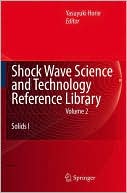

 |

|

Sold Out
Book Categories |
Use of the Z Accelerator for Isentropic and Shock Compression Studies Marcus D. Knudson 1
Introduction 1
Experimental Technique 3
ICE Experimental Configuration 3
MHD Modeling 5
Pulse Shaping 10
Magnetically Accelerated Flyer Plates 13
Analysis Techniques 17
Applications 22
Isentropic EOS Measurements 22
Phase Transitions 24
Constitutive Properties 28
Magnetically Accelerated Flyer Plates 30
Conclusion 38
References 40
Ultrashort Laser Shock Dynamics D.S. Moore S.D. McGrane D.J. Funk 47
Introduction 47
Laser Shock Generation 48
Laser Driven Flyers 48
Ablated Reactive Layer Shock Launch 49
Direct Laser Drive 50
Laser Shock Diagnostics 60
Interferometry 60
Frequency Domain Interferometry (FDI) 61
Ultrafast Interferometric Microscopy 62
Dynamic Ellipsometry 66
Affect on Optical Properties 67
Shocked Metals 67
Shocked Dielectrics 73
Ultrafast Spectroscopy 76
UV/Visible 76
Raman 77
Coherent Raman 78
Infrared Absorption 81
Measurement of Shock Wave Properties 85
Rise Time Measurements 86
Ultrafast Shock-Induced Chemistry 92
Shock-Induced Reaction in Al Nanoparticles 93
Shock-Induced Reaction in Polyvinyl Nitrate Thin Films 94
References 98
Failure Waves and Their Effects on Penetration Mechanics in Glass and Ceramics S.J. Bless N.S. Brar 105
Introduction 105
Summary of Observations of Plane Failure Waves 106
Experimental Methods and Particular Results 108
Chemical Composition and Physical Properties of Various Glasses 108
Elastic Compression of Glass 108
Failure Waves in Glass Plates 110
Failure Waves in Glass Bars 115
Failure Waves in Diverging Stress Fields 119
Failure Waves in Polycrystalline and Single Crystal Materials 121
Proposed Mechanisms and Modeling of Failure Waves 123
Degradation of Shear Modulus of Glass 123
Phase Transformation 124
Elastic Strain Energy 124
Inhomogeneous Shear (Microcracking) Flow 125
Phenomenological Model Based on Damage-Induced, Self-propagating Failure Wave 127
Heterogeneous Microdamage from Stress Concentrations 127
Mesoscale Models 133
Terminal Ballistics 133
Ceramic Armor and Failure Waves 133
Brittle Projectiles 136
References 137
Empirical Equations of State for Solids Ralph Menikoff 143
Introduction 143
Physics Background 144
Thermodynamics 145
Shock Relations 148
Example Hugoniot Loci 151
Complete EOS 154
Ideal Gas EOS 154
Stiffened Gas EOS 155
Hayes EOS 156
Generalized Hayes EOS 159
Mie-Gruneisen EOS 166
Hugoniot as Reference 168
Isentrope as Reference 174
Porous Materials 175
Equilibrium Mixture 178
Wide Domain Model EOS 180
Generalized Mie-Gruneisen EOS 180
Tabular EOS 181
Concluding Remarks 182
References 185
Elastic-Plastic Shock Waves Ralph Menikoff 189
Introduction 189
Uniaxial Flow 190
Hyperelastic Model 191
Flow Equations 194
Shock Locus 196
Example 199
Illustrative Wave Profiles 201
Split Elastic-Plastic Wave 202
Overdriven Plastic Wave 206
Additional Wave Structures 206
VISAR Time Histories 210
Extension to Three-dimensions 214
Elastic Flow 214
Plastic Flow 218
Summary 220
References 223
Elements of Phenomenological Plasticity: Geometrical Insight, Computational Algorithms, and Topics in Shock Physics R.M. Brannon 225
Introduction 225
Notation and Terminology 226
Rate-Independent Plasticity 232
Applicability of the Governing Equations 235
Discussion of the Governing Equations 237
Interpreting and Integrating the Stress Rate 243
Nonhardening von Mises (J[subscript 2]) Plasticity 248
Phantom Inelastic Partitioning 250
Rate Dependence 254
Plastic Wave Speeds 263
Conclusions 269
References 271
Numerical Methods for Shocks in Solids David J. Benson 275
Introduction 275
The History of Hydrocodes 276
The Discretization of Time and Space 277
The Structure of Hydrocodes 279
The Lagrangian Step 280
The Fundamental Importance of the Discrete Gradient Operator 280
Updating the State Variables 282
The Finite Element Method 284
A Finite Difference Method: Integral Differencing 287
The Godunov Method 289
Particle Methods 291
The Shock Viscosity 298
Contact Boundary Conditions 300
Contact Force Calculations 302
The Eulerian Step 304
Modification of the Lagrange Step for Eulerian Formulations: Multi-Material Elements 304
Interface Reconstruction 307
Transport Methods 308
Transport in One Dimension 311
Transport in Two and Three Dimensions 313
Future Research Directions 314
References 315
Mesoscale Modeling of Shocks in Heterogeneous Reactive Materials Mel R. Baer 321
Introduction 321
Microstructure of Composite Explosives 322
Some Historical Observations 323
Detonation at the Mesoscale 324
Mesoscale Modeling Approaches 325
Particle-Based Methods 326
Quasiparticle Methods 328
Direct Numerical Simulation Methods 329
Mesoscale Stochastic Models 333
Mesoscale Model of a Granular Explosive 335
Mesoscale Model of a Composite Explosive 335
Mesoscale Model of Detonation in a Granular Explosive 337
Experimental Studies of Mesoscale Behavior 339
Investigations of Ordered Granular Material 340
Investigations of Disordered Heterogeneous Materials 341
Observations of Mesoscale Reaction Effects 343
Homogenization Methods 344
Linking Modeling to Observations 345
Future Prospective and Summary 349
References 351
Index 357
Login|Complaints|Blog|Games|Digital Media|Souls|Obituary|Contact Us|FAQ
CAN'T FIND WHAT YOU'RE LOOKING FOR? CLICK HERE!!! X
 You must be logged in to add to WishlistX
 This item is in your Wish ListX
 This item is in your CollectionShock Wave Science and Technology Reference Library, Vol. 2: Solids I
X
 This Item is in Your InventoryShock Wave Science and Technology Reference Library, Vol. 2: Solids I
X
 You must be logged in to review the productsX
 X
 X

Add Shock Wave Science and Technology Reference Library, Vol. 2: Solids I, , Shock Wave Science and Technology Reference Library, Vol. 2: Solids I to the inventory that you are selling on WonderClubX
 X

Add Shock Wave Science and Technology Reference Library, Vol. 2: Solids I, , Shock Wave Science and Technology Reference Library, Vol. 2: Solids I to your collection on WonderClub |